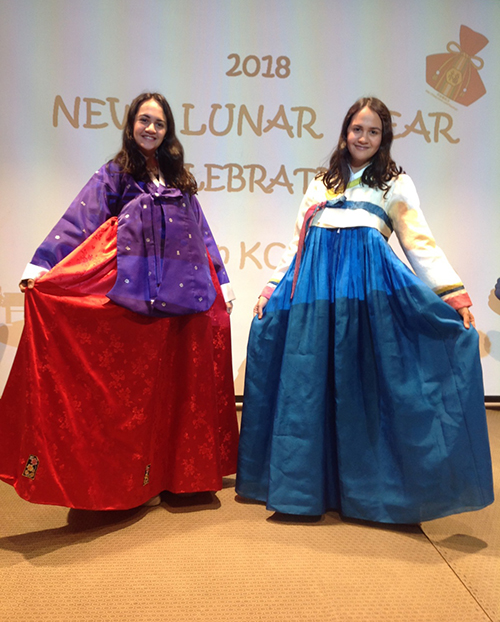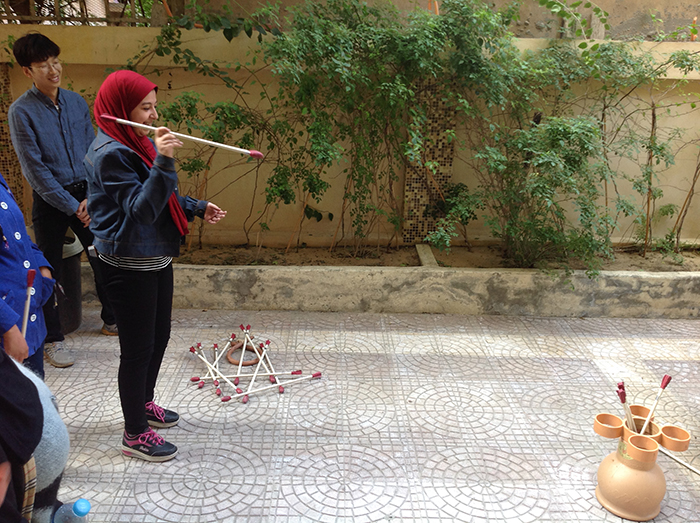-
 Korea.net's 24-hour YouTube channel
Korea.net's 24-hour YouTube channel- NEWS FOCUS
- ABOUT KOREA
- EVENTS
- RESOURCES
- GOVERNMENT
- ABOUT US
View this article in another language
- 한국어
- English
- 日本語
- 中文
- العربية
- Español
- Français
- Deutsch
- Pусский
- Tiếng Việt
- Indonesian
By Korea.net Honorary Reporter Sara Khaled and Dina Khaled from Egypt
Photos = Sara Khaled and Dina Khaled
Cairo l Feb. 15, 2018
They say that experiencing a new culture is like stepping into a whole new world. With a new director at the Korean Cultural Center in Egypt (KCC) and a new lunar year, the KCC gave us an opportunity to experience one of the most important celebrations in the traditional Korean calendar, as Feb. 16 marked the Seollal Lunar New Year and the beginning of a new lunar year.
Seollal is one of the most-celebrated national holidays in Korea. It usually lasts for three days: the day before Seollal Lunar New Year's Day, Seollal Lunar New Year's Day itself, and the day after Seollal New Year's Day. At the beginning of the event, the director of the KCC Yang Sung Hun welcomed us and gave us an introduction to the celebration and to the customs associated with it, from the special foods that are eaten on this day through to the clothes, games and greetings that take place on this day.
Customs, traditions

People start the new lunar year by reconnecting with family and ancestors. Most people try to return to their parents' homes to meet up and to spend time with relatives. In order to not forget one's ancestors, a ceremonial ritual is held on Seollal Lunar New Year's Day called the charye. A lot of special foods are prepared and set in specific places on the offering table. Then family members gather in front of the table and bow to their ancestors as a sort of greeting. This ritual is to express gratitude to the family's ancestors. The bowing to family elders is called the sebae. Children perform a sebae bow while saying, "May you have much luck in the new year," or, "Saehae bok mani badeu-saeyo" (새해 복 많이 받으세요). In return, they receive cash, which is a sort of Lunar New Year's gift that the older people give to the younger people.
After we learned about all of this, we watched a presentation that introduced the traditional style of Korean Hanbok attire. Many people wear traditional clothes during these celebrations. We learned about the different shapes and patterns in Hanbok fashion, and how it evolved throughout time. Hanbok clothes are the colorful traditional clothing style of Korea. They differ according to sex, class, profession, social status and season. In general, there are two main components to a Hanbok wardrobe. For men, their Hanbok is composed of an upper jacket, known as the jeogori, and then pants known as the baji. For women, their Hanbok is composed of an upper jeogori and a skirt known as a chima.
Traditional games, musical instrument

After that, they helped us learn and experience some traditional games that are traditionally associated with Seollal Lunar New Year's. Yeon kite flying is played during the holiday. Traditionally, people flew kites to wish for a good harvest and for the well-being of their family and of the king.
Moreover, we played jegichagi, which is an outdoor game that involves kicking around a shuttlecock, or jegi, that resembles a badminton shuttlecock and is made from a coin and a cloth. We should keep the jegi in the air by kicking it and keeping it from touching the ground. The one with the highest number of consecutive kicks wins the game. We also played tuho which involves tossing a rubber tipped arrows into a quiver.
They also taught us how to play the danso, which is a bamboo flute used in traditional folk music and which has a really mesmerizing sound. The flute has four finger holes and one thumb hole on the back. Using those, the player can make a lot of different sounds and pitches.
Finally, we ended the day by eating a traditional rice cake soup called tteokguk. It's commonly said that one must eat a bowl of tteokguk to become one year older. It's a soup made with sliced rice cake, usually in a beef broth and usually eaten on Seollal Lunar New Year's Day. We also tried other foods, like kimchi.
All in all it was an amazing experience to enjoy, celebrate and learn more about one of the most important traditional Korean celebrations. It was also great to learn that it's not just a normal holiday, but a special occasion encouraging family unity, respecting the ancestors, gathering with family members to play folk games, eating traditional foods, and respecting elders and ancestors.
wisdom117@korea.kr
* This article is written by a Korea.net Honorary Reporter. Our group of Honorary Reporters are from all around the world, and they share with Korea.net their love and passion for all things Korean.
Photos = Sara Khaled and Dina Khaled
Cairo l Feb. 15, 2018
They say that experiencing a new culture is like stepping into a whole new world. With a new director at the Korean Cultural Center in Egypt (KCC) and a new lunar year, the KCC gave us an opportunity to experience one of the most important celebrations in the traditional Korean calendar, as Feb. 16 marked the Seollal Lunar New Year and the beginning of a new lunar year.
Seollal is one of the most-celebrated national holidays in Korea. It usually lasts for three days: the day before Seollal Lunar New Year's Day, Seollal Lunar New Year's Day itself, and the day after Seollal New Year's Day. At the beginning of the event, the director of the KCC Yang Sung Hun welcomed us and gave us an introduction to the celebration and to the customs associated with it, from the special foods that are eaten on this day through to the clothes, games and greetings that take place on this day.
Customs, traditions

Korea.net Honorary Reporters Sara Khaled (left) and Dina Khaled try on some traditional Hanbok dresses at the Korean Cultural Center in Egypt.
People start the new lunar year by reconnecting with family and ancestors. Most people try to return to their parents' homes to meet up and to spend time with relatives. In order to not forget one's ancestors, a ceremonial ritual is held on Seollal Lunar New Year's Day called the charye. A lot of special foods are prepared and set in specific places on the offering table. Then family members gather in front of the table and bow to their ancestors as a sort of greeting. This ritual is to express gratitude to the family's ancestors. The bowing to family elders is called the sebae. Children perform a sebae bow while saying, "May you have much luck in the new year," or, "Saehae bok mani badeu-saeyo" (새해 복 많이 받으세요). In return, they receive cash, which is a sort of Lunar New Year's gift that the older people give to the younger people.
After we learned about all of this, we watched a presentation that introduced the traditional style of Korean Hanbok attire. Many people wear traditional clothes during these celebrations. We learned about the different shapes and patterns in Hanbok fashion, and how it evolved throughout time. Hanbok clothes are the colorful traditional clothing style of Korea. They differ according to sex, class, profession, social status and season. In general, there are two main components to a Hanbok wardrobe. For men, their Hanbok is composed of an upper jacket, known as the jeogori, and then pants known as the baji. For women, their Hanbok is composed of an upper jeogori and a skirt known as a chima.
Traditional games, musical instrument

People practice tuho at the Korean Cultural Center in Egypt.
After that, they helped us learn and experience some traditional games that are traditionally associated with Seollal Lunar New Year's. Yeon kite flying is played during the holiday. Traditionally, people flew kites to wish for a good harvest and for the well-being of their family and of the king.
Moreover, we played jegichagi, which is an outdoor game that involves kicking around a shuttlecock, or jegi, that resembles a badminton shuttlecock and is made from a coin and a cloth. We should keep the jegi in the air by kicking it and keeping it from touching the ground. The one with the highest number of consecutive kicks wins the game. We also played tuho which involves tossing a rubber tipped arrows into a quiver.
They also taught us how to play the danso, which is a bamboo flute used in traditional folk music and which has a really mesmerizing sound. The flute has four finger holes and one thumb hole on the back. Using those, the player can make a lot of different sounds and pitches.
Finally, we ended the day by eating a traditional rice cake soup called tteokguk. It's commonly said that one must eat a bowl of tteokguk to become one year older. It's a soup made with sliced rice cake, usually in a beef broth and usually eaten on Seollal Lunar New Year's Day. We also tried other foods, like kimchi.
All in all it was an amazing experience to enjoy, celebrate and learn more about one of the most important traditional Korean celebrations. It was also great to learn that it's not just a normal holiday, but a special occasion encouraging family unity, respecting the ancestors, gathering with family members to play folk games, eating traditional foods, and respecting elders and ancestors.
wisdom117@korea.kr
* This article is written by a Korea.net Honorary Reporter. Our group of Honorary Reporters are from all around the world, and they share with Korea.net their love and passion for all things Korean.
Most popular
- China warmly welcomes first Korea-born giant panda Fu Bao
- First hearing-impaired K-pop act hopes for 'barrier-free world'
- Novelist Hwang's 'Mater 2-10' shortlisted for Int'l Booker Prize
- Expats could account for 7% of population in 20 years: report
- Nat'l Fire Agency picks 137 elite staff for deployment abroad













